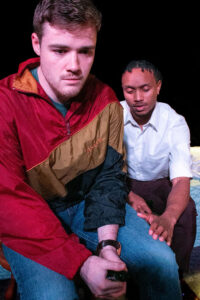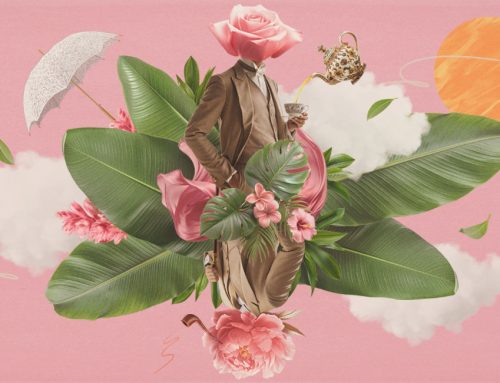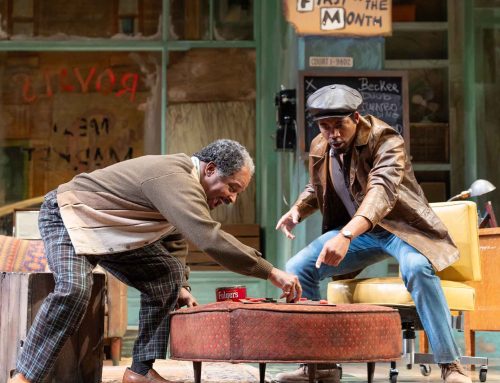written by Ken Urban
directed by Alan Quismorio
San Francisco, CA
at Theatre Rhinoceros
I have stared at the computer screen for too long, trying to come up with a description of A Guide for the Homesick which is as positive-sounding as I feel about the production. I give up.
So, I will join The Rhino itself and other reviewers that make the storyline sound too gay, too implausible, and too simple: it’s a story about two men who pick each other up in a hotel bar. Sprinkle in social concerns about American missionaries invading Africa, unclear gender attraction, and mental illness. Stir and you have the play!
Except that when you’re at the theater you feel no patina of the show being either trite or being good for you. Instead you’re drawn into the personalities, the logical surprises, and surprisingly wonderful production values.

(Pictured l. to r.) Ian Brady plays Jeremy/Ed and Jordan Covington plays Teddy/Nicholas.
Photo by Vince Thomas.
First, Jordan Covington (Teddy/Nicholas) and Ian Brady (Jeremy/Ed) are spectacular young actors. They shift between their two roles flawlessly, and Jordan in particular has a feeling of contained power that he displays at decisive moments. I swear he had tears in his eyes in a scene as Nicholas when 10 seconds previously he was chattering on blithely as Teddy.
Each character plays two characters and action occurs in Africa and Amsterdam. The swapping of identities and locations occurs instantaneously and clearly. Kudos to Director Alan Quismorio and the technical staff that make the changes in lighting and sound at just the right moment with just the right intensity.
The stories of the characters reveal themselves at slowly and with emotional pain which is point of the 90-minute performance. Ken Urban makes us want to know more and more, even when we fear what may happen.
So, another shout-out to Theatre Rhino for its play selection. It’s a gay-themed story that doesn’t have tired campiness or appeal to only the over 65 crowd. This show is serious and set in current times with modern youthful characters.
The final triumph to mention is The Rhino’s overcoming its current small space and making excellent choices in design. The audience sits in two rows of folding chairs about three feet from “the stage”. The stage is just the floor of a room that is a small commercial space. But, I saw the hotel room and the African clinic. The actors and technical staff made it easy for me to believe.
Of course, I would do some things differently. The most notable change I’d make is to the [spoiler alert] sex scene. The Rhino delivers it with on stage nudity — the actors are under the bedding, but their nakedness is pointed. We watch the actors dress the next morning and Jordan has a beautiful bare butt while Ian keeps the covers in front of him while he grabs underwear and puts it on. Instead of stripping under the covers and dressing again, I would have done a simple bedtime black out. I understand the gay demographic of The Rhino’s core audience likes naked men. Still, I felt the in-your-face nudity added nothing and would make me hesitate to recommend the play to some of my friends.
However, the bottom line is that the overall quality of the play, the performances, and the production earns A Guide to the Homesick 5 stars. Go see it, now through March 19th.
Ozdachs rating: ![]()






What does “too gay” mean?
How does one scene with a discretely covered groin and “a beautiful bare butt” add up to “in-your-face-nudity”?
Who are these delicate friends of yours who would be so uncomfortable with a bare butt that you would deny them the opportunity to see good art.
Thanks for commenting…
“Too gay” because the simple synopsis is that two men meet in a gay bar pickup. That doesn’t capture the depth of the relationships and instead makes the story sound like a trite gay romance novel.
As for the nudity, it felt forced. I felt pandered to.
Maybe I’m wrong, but I think a lights-out scene would have been just as powerful. And, my theater-loving friends would probably not be uncomfortable, but they would have rolled their eyes to say that “of course a gay threater company would take the actors’ pants off”.
Moreover, I think this play should get wider, mainstream exposure and whether or not someone “should” get upset over the nakedness, that nakedness will inevitibly distract some people from following the play.
We are in agreement that the play deserves wide attention.
The play’s narrative does not begin in a gay bar pickup; that is your prejudice being overlaid upon the script. One of the two characters is not even openly gay. The play’s narrative begins in the lobby bar of the hotel.
The “simple synopsis” you cite about “a gay bar pick-up” is one that you have concocted on your own. The Rhino’s synopsis, online and in press releases, is:
“On his way home after a year in East Africa, a young aid worker returns to a shabby Amsterdam hotel room with a fellow American. Over beers, the two strangers confess their shared fear of betraying the friends who needed them most.”
One reason that the nude scene could not easily be replaced by a blackout is that
the nudity is no sudden strip-down, but a gradual disrobing throughout a conversation/mutual seduction that helps us understand the awkwardness and discomfort that the younger man feels around his sexuality.
Another reason is the script. Which includes the disrobing, not a black out. This is the choice of the playwright and it would be entirely inappropriate for the Rhino to produce it otherwise, or to suggest to the playwright, as you indirectly have, that he is trying to titillate.